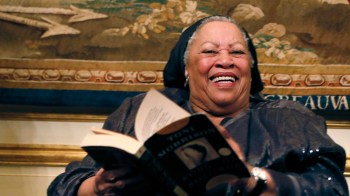Twitter invites writers to think beyond 140 characters
Share Now on:
Twitter invites writers to think beyond 140 characters
What’s the pay-off for writers to keep sharing online? Twitter and publishers say the answer is simple: The social platform offers access to new audiences and book buyers.
Twitter, the Association of American Publishers (AAP), and Penguin Random House (the publishing company that merged in mid-2013) organized a writing competition and a series of in-person and online events for writers. #TwitterFiction Festival, running March 12-16, includes formal talks and informal chats with a logophile cornucopia: published writers, young and old writers, unpublished but professional writers, famous writers who aren’t writing as much anymore, and the “new” and undiscovered writer.
In fact, #TwitterFiction is not really about any specific genre of storytelling. The organizers even included a category for non-fiction submissions, making the event more about writing andwriters, than the actual genre of fiction. #TwitterFiction isn’t really about Twitter itself, either, although it’s certainly not about the writing on Facebook walls.
Twitter emphasizes new writing styles the social network is known to appreciate and promote:
“We encourage writers to use Twitter in a variety of ways — everything from connecting with their readers to experiments with new forms of narrative. Twitter is even a great way for writers to play with visual narratives in real time. We ask them to be experimental – taking the art of storytelling and character-creation and using Twitter to bring it to life. Twitter is a wide open frontier for creative experimentation with a built-in global audience of millions and we encourage writers to take advantage of that.” – Andrew Fitzgerald, media partnerships at Twitter
The event’s website offers a creative tweet generator, which is a great Mad Libs for the 140-character set.
And answering the question of what the event isn’t (an event about Twitter or fiction or meeting new people in-person) reveals what it is: an attempt by a more traditional industry to meet the demands of the social media age by mimicking its personality.
Twitter wants to be form-friendly
It’s perhaps not a surprise that social media is a willing participant in a project that allows it to counter criticisms that Twitter is killing the English language. It also makes sense for Twitter to find creative ways to help content creators feel comfortable using the network as a publishing and promotional tool.
I tweet that I have a book, that I like a book, that I like your book… and all of a sudden I am hooked to a regular stream of information. Twitter is looking for new sources of revenue, and the more active users of its technology the better, if only from a purely fiscal point of view.
No one will check your follower count if you tweet away at #TwitterFiction, publishers aren’t treating it like the last pitch they will ever take from you, and writers have embraced the opportunity to do what they love best. However, this unique collaboration doesn’t mean there aren’t high stakes.
Twitter is a publishing and a promotional platform, to be sure — but is it a marketplace where creative content, such as works of fiction, can be sold and bought?
And how does the supply-side (the authors and the publishers) see Twitter? Mostly as a way to reach the demand side (readers). Authors want to be read, and Twitter gives them instant gratification, in a sense. I asked Twitter what they think writers gain from using the network and attending such events:
“#TwitterFiction is a great way for writers to challenge themselves with a new genre or new technique. It’s also really beneficial to writers because Twitter makes for such an interesting stage: authors are essentially performing their work in front of a live, global audience. Twitter Fiction offers something traditional writing does not, as the possibility for creative storytelling are endless.” – Andrew Fitzgerald, Twitter
Soft-selling books on social media
Author and non-fiction #TwitterFiction contest winner Adam Popescu, 29, says at first he was concerned that sharing an entire chapter of his (as-of-yet unpublished) book about a trip to the base of Mount Everest would result in a net loss. Popescu (who has worked on contract for Marketplace) was surprised to see his following increase by 700 people on the popular community site Wattpad after he published the chapter.
When asked if he ever reached out directly on Twitter to publisher accounts (@-replying or @-mentioning publishers to get their attention), Popescu said that using Twitter is a delicate balance for writers. Using the platform without spending time to understand or engage in the reader community is “the equivalent of making a joke on a public stage, and then pointing to someone in the fourth row to ask if they got it,” Popescu noted.
Authors: Tweet to @MarketplaceAPM and tell us if you’ve successfully reached out to publishers online.
Petru Popescu, 70, who is both Adam’s father and a successfully published author himself, sits apart from his son — on the suspicious-of-sharing-content-online camp, so I asked him what he thought about his son’s success writing both short and long form online:
“[On Twitter] you can’t be long winded AT ALL, your readers don’t look for rhetoric effect/intellectual complication; you have to have a voice, EVEN TWEETING, actually more so, because the space is so limited. The first person narrative, the ultra direct engaging of readers, those are writing ways of great value.” – Petru Popescu
UPDATE: We received comments on #TwitterFiction from Emma Straub, author of The Vacationers, Laura Lamont’s Life in Pictures, and Other People We Married, on how she approaches Twitter for writers. Straub highlights the community on Twitter which she is able to see and particpate in:
“Before I had a baby, Twitter was my pretend office, a place I could go to talk about cheese and television and books and my cats. Nowadays I use it more sleepily, as a late night companion, an insomniac friend. I know lots of writers find Twitter too distracting, but I really love being able to dip in and out and see what people are up to. Maybe that doesn’t answer your question. I suppose that what I gain (as a writer) is a conversation. Some writers like to hide in their garrets, but I’m not one of those. I’m an extrovert in an introvert’s universe, and Twitter is a bubbly, chatty place for the likes of me.
“There are very few writers who I think use Twitter really well–that is, writers who are clearly having fun playing with the form itself. Teju Cole, Gary Shytengart, Colson Whitehead. Poets are often good, practiced as they are in pithiness. Standalone tweets, be they funny or wry or sarcastic or what have you, are the best. And, of course, the key to writing while using the platform is to turn it off.” – Emma Straub, author
If Twitter builds it, they should come
Publishers, too, see Twitter’s short form style as a good way to introduce a soft sell. The bird du jour has won the favorable participation of well-heeled publication houses, which have a continual influx of submissions using traditional means.
In explaining its participation, Penguin Random House focused on the use of reader engagement on Twitter:
“Penguin Random House believes that social media is an excellent way for publishers and authors to connect with readers. There is an active and enthusiastic community of book lovers on Twitter who are very engaged in the conversation about books and reading.” – Christine McNamara, Vice President and Director of Partnerships at Random House
On making Twitter a friendly place for book buyers:
“We have seen tremendous interaction on Twitter through the various accounts and dialogs we participate in. It’s our experience that the conversation surrounding books on Twitter is diverse, smart, dynamic, and constant. Innovative events like the TwitterFiction Festival provide a wonderful opportunity for celebrating storytelling in its myriad forms and engaging with readers all over the world. We are proud to be one of the supporters for this great celebration of storytelling.” – McNamara, Random House
AAP on its members, publishers, and authors/writers (a list of their featured participants at #TwitterFiction):
“The publishers who are our member organizations are committed to promoting the joy of reading and improving literacy. We get involved in a number of such initiatives supporting that mission and this fit perfectly. …We welcome opportunities that showcase authors, writers and the expertise required in compelling storytelling.” – Andi Sporkin, AAP
#TwitterFiction shows the strength of Twitter’s user base and access to readers, the demand-side of the social platform. If Twitter can pull off becoming a platform for buying and selling, one suspects it could attempt the same with other media, too: news, photography, film, oil paintings, clothing… the list goes on.
Publishers are reaching out to readers. Authors are reaching out to readers. Twitter is helping the industry to showcase its work in all forms. The market is set for selling success. The only unknown is whether writers and authors-to-be will continue to share online. Concerns still exist, and publishers do not appear to be using social media to open up the field for writers.
As long as Twitter and publishers keep trying, writers should take note: the readers are out there, tweeting, and reading.
There’s a lot happening in the world. Through it all, Marketplace is here for you.
You rely on Marketplace to break down the world’s events and tell you how it affects you in a fact-based, approachable way. We rely on your financial support to keep making that possible.
Your donation today powers the independent journalism that you rely on. For just $5/month, you can help sustain Marketplace so we can keep reporting on the things that matter to you.


















